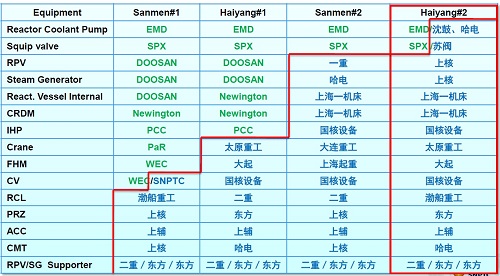Кто о чем, а я напишу немного о ВХР АР-1000.

Если ошибся темой, бывает.
Первый контур, глава 5.2, таблица 5.2-2, стр 5.2-39.
REACTOR COOLANT WATER CHEMISTRY SPECIFICATIONSElectrical conductivity - Determined by the concentration of boric acid and alkali present. Expected range is <1 to 40 μmhos/cm at 25°C.
Solution pH - Determined by the concentration of boric acid and alkali present. Expected values range between 4.2 (high boric acid concentration) and 10.5 (low boric acid concentration) at 25°C. Values will be 5.0 or greater at normal operating temperatures.
Oxygen(1) - 0.1 ppm, maximum
Chloride(2) - 0.15 ppm, maximum
Fluoride(2) - 0.15 ppm, maximum
Hydrogen(3) - 25 to 50 cm3 (STP)/kg H2O
Suspended solids(4) - 0.2 ppm, maximum
pH control agent (Li7OH) (5) - Lithium is coordinated with boron per fuel warranty contract.
Boric acid - Variable from 0 to 4000 ppm as boron
Silica(6) - 1.0 ppm, maximum
Aluminum(6) - 0.05 ppm, maximum
Calcium(6)+ magnesium - 0.05 ppm, maximum
Magnesium(6) - 0.025 ppm, maximum
Zinc(7) - 0.04 ppm, maximum
Теперь, важные примечания:
Notes:
1. Oxygen concentration must be controlled to less than 0.1 ppm in the reactor coolant
by scavenging with hydrazine prior to plant operation above 200°F (93.33°C). During power operation with the specified hydrogen concentration
maintained in the coolant, the residual oxygen concentration will not exceed 0.005 ppm.
2. Halogen concentrations must be maintained below the specified values regardless of system temperature.
3. Hydrogen must be maintained in the reactor coolant for plant operations with nuclear power above 1 MW. The
normal operating range should be 30-40 cm3 (STP) H2/kg H2O.
4. Solids concentration determined by filtration through filter having 0.45-μm pore size.
5. The specified lithium concentrations must be established for startup testing prior to heatup beyond 150°F (65.56°C).
During cold hydrostatic testing and hot functional testing inthe absence of boric acid, the reactor coolant limits for
lithium hydroxide must be maintained to inhibit halogen stress corrosion cracking.
6. These limits are included in the table of reactor coolant specifications as recommended standards for monitoring
coolant purity. Establishing coolant purity within the limits shown for these species is judged desirable with the
current data base to minimize fuel clad crud deposition, which affects the corrosion resistance and heat transfer of
the clad.
7. Specification is applicable during power operation when zinc is being injected. The zinc concentration is maintained
at the lower of 0.04 ppm or that specified in the reload safety analyses.
Нашелся таки гидразин.
Далее ВХР 1-2 контуров упоминается в главах 5.4, 9.3, 10.3. Однако, всвязи с приближением праздника, немного посмешим общественность. Итак, глава 6.2, стр. 6.2-71:
Chemical Addition Tank – The chemical addition tank is a small, vertical, cylindrical tank that is sized to inject
a solution of hydrogen peroxide to maintain a passive containment cooling water storage tank concentration for control of algae growth.
Похоже, граждане проектанты решили применять раствор перекиси водорода (Н2O2) для контроля роста водорослей(!?) в PCCWST (Passive Containment Cooling Water Storage Tank), который встроен в оболочку реакторного здания, выше ГО, объем указывал, и в PCCAWST (Passive Containment Cooling Ancillary Water Storage Tank), расположенном на уровне земли. Красота. В разных значениях этого слова.
 https://www.ukap1000application.com/PDFDocs...ction%205-2.pdfhttps://www.ukap1000application.com/PDFDocs...ction%206-2.pdf
https://www.ukap1000application.com/PDFDocs...ction%205-2.pdfhttps://www.ukap1000application.com/PDFDocs...ction%206-2.pdfP.S. За отсутствие перевода извиняюсь, могу чуть-чуть напутать.
P.P.S. Жду экспертного заключения о применимости АР-1000 в качестве РБН, использования его в ЗЯТЦ, или в качестве ЭБ с термоядерной генерацией э.э.

